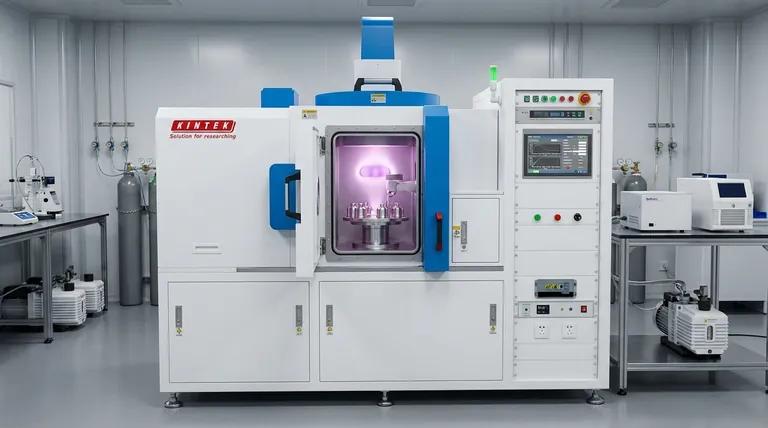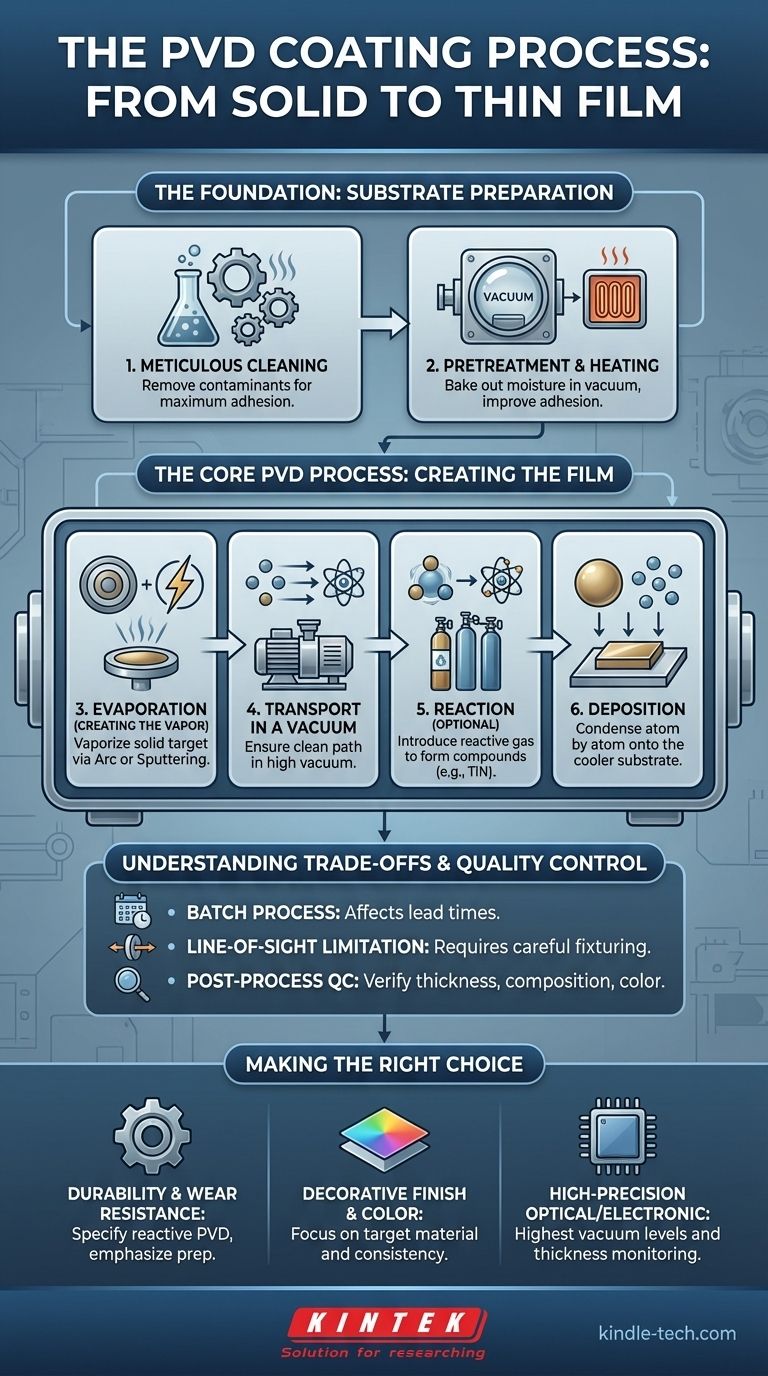At its core, the Physical Vapor Deposition (PVD) process is a sophisticated vacuum coating technique that transforms a solid material into a vapor, which then condenses onto a target object as a thin, high-performance film. The process can be conceptually broken down into three main phases: turning a solid into a gas (evaporation), moving that gas to the part (transport), and condensing the gas back into a solid on the part's surface (deposition).
PVD is not a single process, but a family of atomic-level coating methods. The key to understanding it is to see it as a highly controlled sequence: preparing a pristine surface, vaporizing a source material in a vacuum, and then precisely depositing that vapor atom-by-atom onto the part.

The Foundation: Substrate Preparation
Before any coating can begin, the part to be coated—known as the substrate—must be impeccably prepared. This stage is non-negotiable and is often the most critical factor in the final quality of the coating.
Step 1: Meticulous Cleaning
The substrate is subjected to a rigorous cleaning process to remove any contaminants. This includes oils, grease, dust, or oxides from manufacturing and handling.
Any residue left on the surface will prevent the coating from adhering properly, leading to defects, poor performance, and potential flaking. Think of it like trying to apply a sticker to a dusty, oily surface—it simply won't stick well.
Step 2: Pretreatment and Heating
After cleaning, the parts are loaded into the vacuum chamber. The chamber's atmosphere is then evacuated to create a high vacuum.
The parts are often heated to a specific process temperature. This heating helps bake out any remaining trace moisture or volatile contaminants and improves the eventual coating adhesion and structure.
The Core PVD Process: Creating the Film
This is where the transformation occurs. Inside the high-vacuum chamber, a sequence of physical processes is initiated to build the coating layer by layer, or more accurately, atom by atom.
Step 3: Evaporation (Creating the Vapor)
The solid source material, known as the target, must be converted into a vapor. This is typically achieved through one of two primary methods:
- Thermal Evaporation / Arc Evaporation: The target material is heated using an electrical arc or resistive heater until it boils and vaporizes.
- Sputtering: The chamber is backfilled with a small amount of an inert gas (like Argon). A powerful plasma is created, and the gas ions are accelerated into the target, physically knocking atoms loose, much like a sandblaster dislodges particles.
Step 4: Transport in a Vacuum
The vaporized atoms travel from the target to the substrate. The high-vacuum environment is crucial here.
Without a vacuum, the vaporized atoms would collide with air molecules, losing energy and reacting with oxygen and nitrogen in unpredictable ways. The vacuum ensures a clean, direct path.
Step 5: Reaction (Optional)
For many advanced coatings (like nitrides or carbides), a reactive gas such as nitrogen or methane is introduced into the chamber at a precisely controlled rate.
The vaporized metal atoms react with this gas mid-flight or on the substrate's surface to form a new compound. This is how materials like Titanium Nitride (TiN), known for its gold color and hardness, are created.
Step 6: Deposition
As the vaporized atoms (or newly formed compound molecules) arrive at the cooler substrate, they condense and form a thin, dense, and highly-adherent film.
Because this happens atom by atom, the coating can replicate the substrate's surface texture with extreme fidelity, from a mirror polish to a matte finish. The thickness is carefully monitored in real-time to ensure it meets specifications.
Understanding the Trade-offs and Quality Control
While PVD offers exceptional results, it is a complex industrial process with specific constraints. Understanding these is key to leveraging it effectively.
The Batch Process Nature
PVD is a batch process, not a continuous one. Parts must be loaded, the chamber sealed, the vacuum created, the process run, and then the chamber cooled and vented. This cycle can take several hours, which influences lead times and cost.
Line-of-Sight Limitation
Most PVD processes are "line-of-sight," meaning the coating is primarily deposited on surfaces that have a direct, unobstructed path from the vaporization source. Parts must be carefully fixtured and often rotated during the process to ensure uniform coverage. Deep recesses or complex internal geometries can be very challenging to coat.
Post-Process Quality Control
After the parts have cooled and been removed from the chamber, they undergo strict quality control.
Specialized equipment like X-Ray Fluorescence (XRF) analyzers and spectrophotometers are used to verify the coating's thickness, composition, and color against the required specifications. Adhesion tests may also be performed to ensure the coating is properly bonded.
Making the Right Choice for Your Project
Use your understanding of these steps to align the process with your goal.
- If your primary focus is durability and wear resistance: Specify a reactive PVD process (like TiN, CrN, or AlTiN) and emphasize the critical importance of substrate material and surface preparation.
- If your primary focus is a decorative finish and color: The choice of target material and reactive gas is paramount, and process consistency from batch to batch is the key challenge to discuss with your coating partner.
- If your primary focus is a high-precision optical or electronic film: Emphasize the need for the highest vacuum levels and precise thickness monitoring to ensure film purity and uniformity.
By grasping this step-by-step framework, you can more effectively collaborate with PVD specialists to achieve a final product that is both beautiful and built to last.
Summary Table:
| Step | Key Action | Purpose |
|---|---|---|
| 1. Substrate Cleaning | Remove oils, grease, and oxides | Ensure maximum coating adhesion |
| 2. Pretreatment & Heating | Heat parts in a vacuum chamber | Bake out contaminants, improve adhesion |
| 3. Evaporation | Vaporize the target material (e.g., via sputtering) | Create the vapor for deposition |
| 4. Transport | Move vapor through a high-vacuum environment | Ensure a clean, direct path to the substrate |
| 5. Reaction (Optional) | Introduce reactive gas (e.g., Nitrogen) | Form compound coatings like Titanium Nitride (TiN) |
| 6. Deposition | Condense vapor onto the substrate | Build a thin, dense, and highly-adherent film |
Ready to achieve superior durability and performance for your components? The PVD coating process is complex, but the results are unmatched. KINTEK specializes in precision lab equipment and consumables essential for surface preparation, vacuum chamber operation, and quality control in PVD applications. Whether you're developing wear-resistant tools, decorative finishes, or high-precision optical films, our solutions support every critical step. Let's perfect your coating process together—contact our experts today to discuss your specific needs.
Visual Guide

Related Products
- RF PECVD System Radio Frequency Plasma-Enhanced Chemical Vapor Deposition RF PECVD
- Chemical Vapor Deposition CVD Equipment System Chamber Slide PECVD Tube Furnace with Liquid Gasifier PECVD Machine
- Split Chamber CVD Tube Furnace with Vacuum Station Chemical Vapor Deposition System Equipment Machine
- VHP Sterilization Equipment Hydrogen Peroxide H2O2 Space Sterilizer
- Molybdenum Tungsten Tantalum Special Shape Evaporation Boat
People Also Ask
- How are PECVD and CVD different? A Guide to Choosing the Right Thin-Film Deposition Process
- What is an example of PECVD? RF-PECVD for High-Quality Thin Film Deposition
- What are the advantages of PECVD? Enable Low-Temperature, High-Quality Thin-Film Deposition
- Why is PECVD environment friendly? Understanding the Eco-Friendly Benefits of Plasma-Enhanced Coating
- What is the principle of plasma enhanced chemical vapor deposition? Achieve Low-Temperature Thin Film Deposition



















